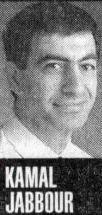

Sub 2-Hour Marathon
Need For Speed
Published November 29, 1999 in The Post-Standard.By Dr Kamal Jabbour, Contributing Writer
Oct. 24, 1999, all eyes turned toward Chicago where an elite field competed in the LaSalle Bank Chicago Marathon in less than ideal conditions. The cold and windy weather could not delay Khalid Khannouchi as he covered the 26.2 miles in a world record time of 2 hours, 5 minutes and 42 seconds.
Seconds later, Moses Tanui crossed the finish line in a time of 2:06:16, the fastest losing time in history. In fourth place, David Morse finished in 2:09:32 to set an American record, previously held by Chittenango native Jerry Lawson.
Khannouchi's world record was nothing short of sensational. In the preceding months, the Ossining resident had demonstrated the discipline and speed necessary to challenge and break the world record. Given his fitness level, he might have run even faster in calmer weather.
Every time the marathon world record is lowered, which is not a common occurrence, speculations rise on the possibility of a sub-2 hour marathon. Mathematicians extrapolate their polynomial projections, physiologists revise their VO2 (an athlete's submaximal oxygen consumption) tables, and reporters fumble their calculators dividing time by distance.
To establish the total arbitrariness of the 2-hour barrier, we only need to realize that both the marathon and the hour are arbitrary measures of distance and time. The marathon distance of 26 miles, 385 yards dates to the London Olympic marathon, when the course was moved to permit the royal grandchildren to watch the start from Buckingham Palace. The choice of an hour to measure time, as a fraction of one rotation of the earth around its axis, is equally arbitrary.
The 2-hour marathon barrier is as arbitrary as the 4-minute mile or the 10-second 100-meter sprint. Nevertheless, the question remains whether man is capable of running a marathon under 2 hours.
The Purdy-Gardner tables for predicting running performance, published in 1970, stop at a 2:01:29 marathon. This performance equates to 26:08 for 10,000 meters, much faster than the current world record. A 2-hour marathon corresponds to a 25:45 10,000 meters, off the tables and the proverbial horizon.
Arthur Lydiard, the renowned exercise physiologist and running coach, predicted more than three decades ago that a 2:05 marathon is the limit of human performance.
I am tempted to agree with Lydiard's limit with a slight qualifier. If 2:05 is indeed the limit of human performance, this limit probably applies to a barefoot runner racing on a soft surface. Recent advances in running shoe design may account, at least in part, to recent world records.
The latest craze in running shoe design revolves around energy return systems. With everything from a torsion bar to a gel pouch, shoemakers try to convert wasted energy into forward motion. These gadgets may someday yield the desired 4 percent improvement in speed.
Besides advances in running shoe design, nutrition and training methods are expected to play a significant role in further improvements. Nutritional supplements and energy replacement products will enhance recovery and performance, while a scientific basis to training will yield a higher racing return on training investment.
There must exist a limit, dictated by physics and physiology yet unknown to us, under which no one will run. Purely mathematical projections suggest the year 2012 as the likely intersection between an exponentially declining time curve and the 2-hour axis.
In the meantime, Khannouchi confirmed his plans to run in the London Marathon next spring, raising expectations of another drop in the world record.
Kamal Jabbour enjoyed a summertime running chat with Khannouchi. His RUNNING Column appears in The Post-Standard on Mondays. He maintains TrackMeets.com, the world leader in live track webcasting, and receives email at jabbour@syr.edu.
